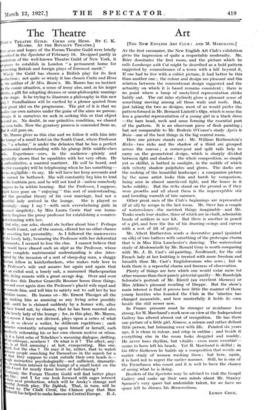Art
[THE NEW ENGLISH ART CLUB: AND M. Miaterekszn.] AT the first encounter, the New English Art Club's exhibition gives the impression of quite a respectable modernity. Mr. Ihlee dominates the first room, and the picture which he calls Landscape with Cat might be described as a bold pattern suggested by remembrance of a town with a hill beyond it If one had to live with a cubist picture, it had better be this than another one ; the colour and design are pleasant and the relation between the conventional design suggested and the actuality on which it is based remains consistent ; there is no point where a lump of unstylized representation sticks baldly out. The cat (also stylized) gives a pleasant sense of something moving among all those walls and roofs. But, just taking the two as designs, most of us would prefer the pattern formed in Mr. Bernard Lintott's Olga, which is none the less a graceful representation of a young girl in a black dress —the bare head, neck and arms forming the essential part of the pattern. It is an observant piece of flesh painting ; but not comparable to Mr. Roderic O'Conor's study Apres le Bain—one of the best things in the big central room.
Here one picture stands out : Mr. William Rothenstein's Ricks—two ricks and the shadow of a third are grouped across the canvas ; a corner-post and split rails help to carry on the geometrical design, which is sharply divided between light and shadow ; the whole composition, so simple yet so skilful, is bathed in sunlight, in the middle of which rich velvety shadow palpitates and glows. The darks arc the making of the beautiful landscape ; a companion picture by the same artist looks thin and harsh by comparison, being seen in almost unrelieved light, and the house in it lacks solidity. But the ricks stand on the ground as if they were growths and all about them is the imperceptible stir and breeding warmth of late summer.
Other great men of the Club's beginnings are represented (if at all) by scraps in the last room. Mr. Steer has a couple of watercolours—the moistest things imaginable—and Mr. Tonks sends four studies, three of which are in chalk, admirable heads of soldiers in war kit. But there is another in pencil of a girl, and here the line of his drawing swings and curves with a sort of lilt of gaiety.
Mr. Albert Rutherston sends a decorative panel (painted on silk) of two bathers with something of the grotesque charm that is in Miss Elsa Lanchester's dancing. The watercolour study of Mademoiselle by Mr. Ronald Gray is worth comparing with Mr. J. D. Cast's oil-painting, Needlework, for the old French lady at her knitting is treated with more freedom and breadth than Mr. Cast's Englishwoman who sews ; but in both there is a reposeful charm and fineness of observation.
Plenty of things are here which one would value more for other reasons than their purely pictorial quality—Mr. Randolph Schwabe's portrait of Mr. Birrell (an excellent likeness) or Miss Atkins's pleasant recalling of Dieppe. But the show's main interest is that it proves how little the manner of those young heretics who founded the Club in the 'nineties has changed meanwhile, and how masterfully it holds its own beside the still newer new.
In France pressure must be stronger or resistance less strong, for M. Marchand's work now on view at the Independent Gallery has altered almost out of recognition. He has there one picture of a little girl, Simone, a solemn and rather defiant little person, but brimming over with life. Painted six years ago, it is clean in colour, and crisp in outline ; and beside it everything else in the room looks draggled and muddy. He never loses rhythm, but vitality—even more essential— seems to have left his brush. Yet M. Marchand is skilful ; in his Olive Gatherers he builds up a composition that recalls an earlier study of women washing linen ; but here, again it is hard not to regret the earlier manner. Still, he is one of the Frenchmen who count and it is well to have the chance of seeing what he is doing. Readers of the Spectator may be advised to visit the Goupil Gallery and make up their own minds about Mr. Stanley Spencer's very queer but undeniable talent, for we have no space left to discuss his Resurrections.
' LEMON GREY.






























































 Previous page
Previous page